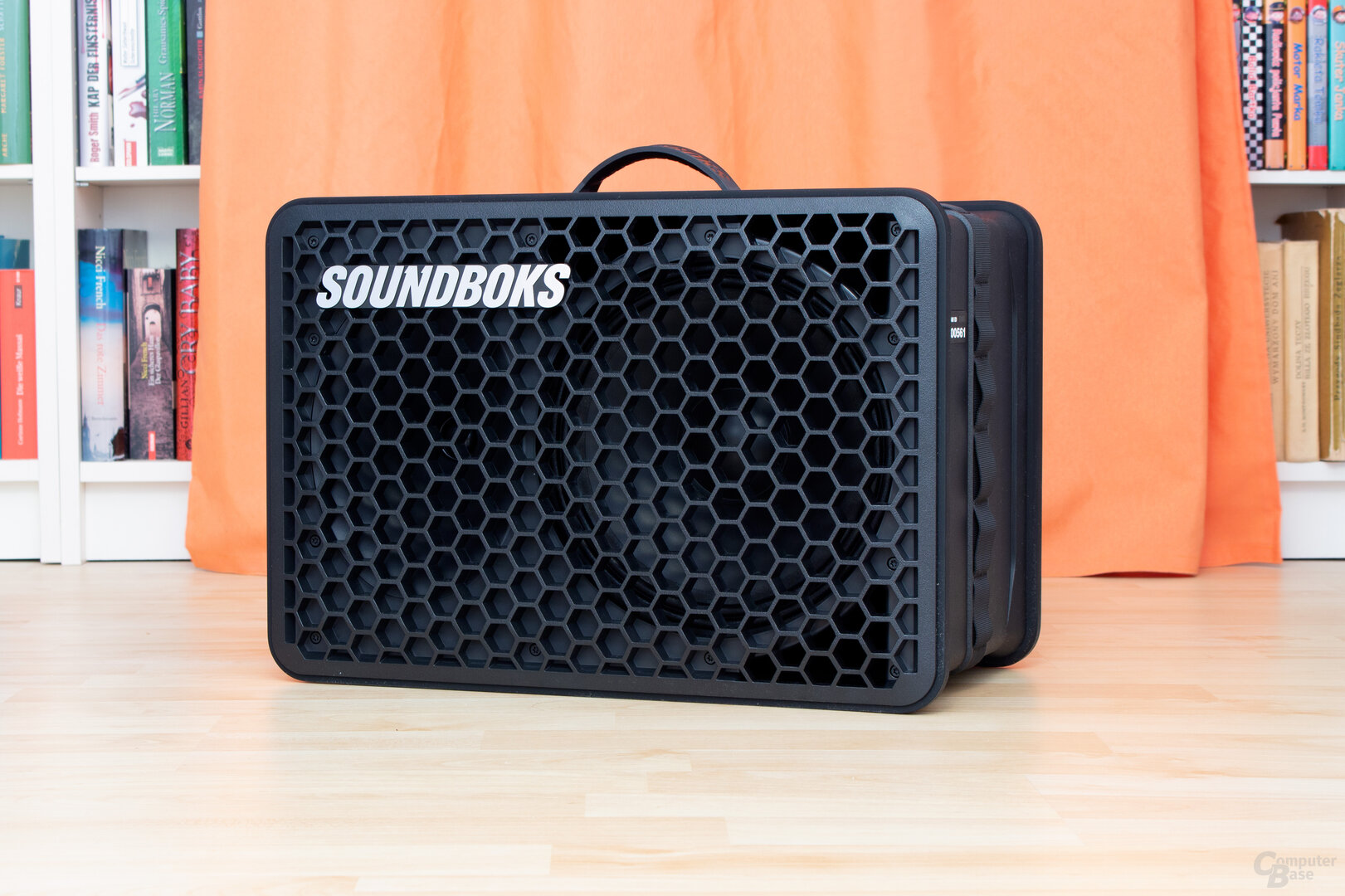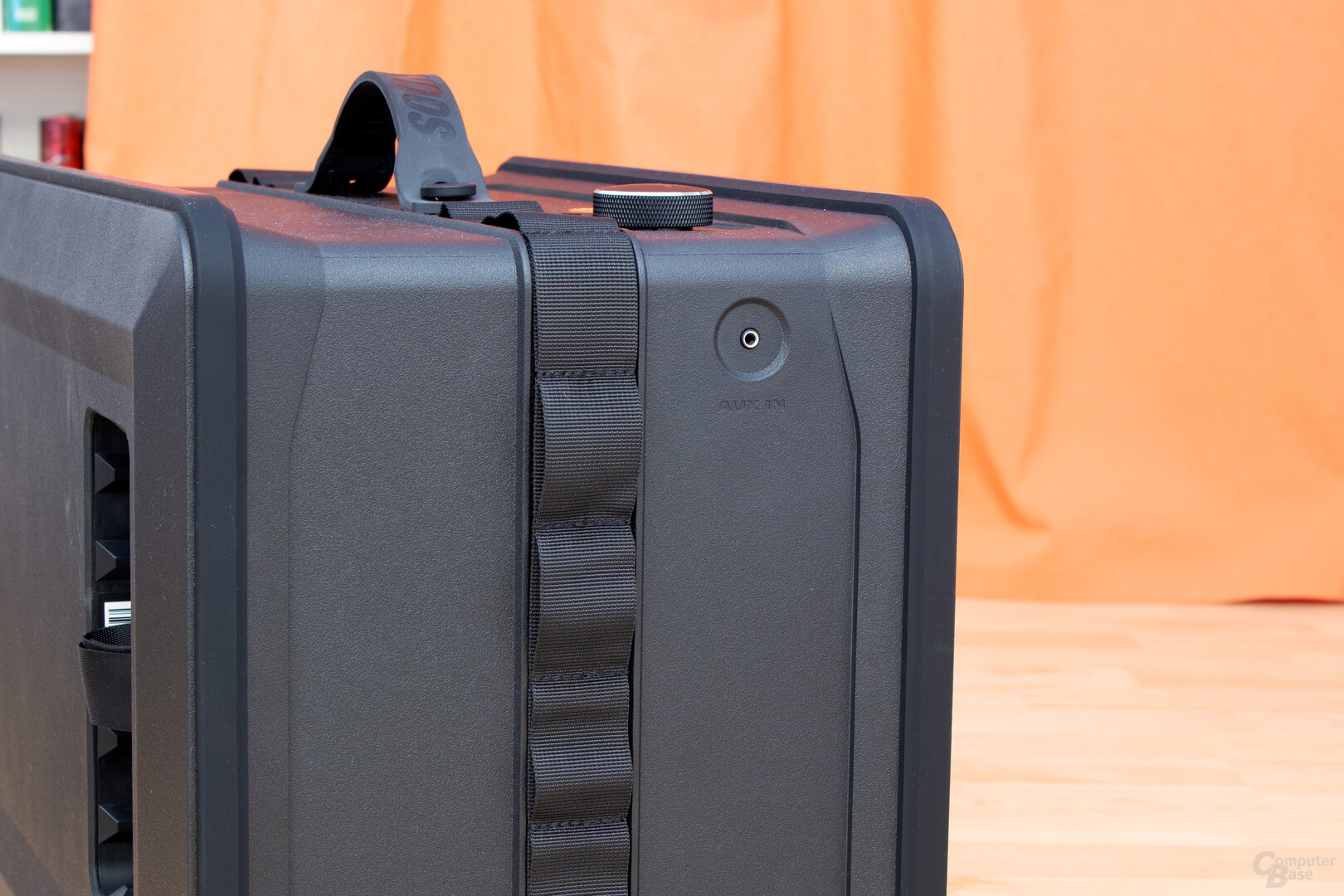With the Go, Soundboks is adding a slightly more portable version to its speaker portfolio, which thanks to its generous battery can last a long time without a power outlet. But although its area of application and the target group are very narrow, the sound generator knows how to convince in large parts. Still, it's not perfect.
Table of Contents
- 1 Well-built speaker for many hours of listening
- Design and workmanship
- Connections and controls
- 2 Sound and runtimes
- Above all, it should be loud
< li>Power supply and runtimes
Design and processing
Compared to The New Soundboks (test), which currently represent the third generation of the Danish manufacturer's large loudspeakers, the three-year age difference of the more mobile newcomer is already apparent from the outside. The new representative in the portfolio no longer exudes the whiff of concert equipment, but presents itself with much rounder and more modern forms – the simplicity, which primarily characterized the predecessors, could be retained.
 Testing Soundboks Go
Testing Soundboks GoBut there are also differences under the hood: The body is now made of ABS and polycarbonate and no longer made of poplar plywood like its big brother. This should make the Soundboks Go, as the manufacturer calls it, “dent-proof”. In contrast to the large speaker, where the front grille was still made of metal, Soundboks now uses a plastic grille. But while the metal grille quickly gives in to impacts and thus dents but otherwise remains intact, the new variant is better at absorbing impacts, but due to its rigidity it breaks directly at one point.
The loudspeaker is also surrounded by two rubber rings, which on the one hand ensure a certain decoupling of the bass tones and thus avoid sound distortions on the other hand also guarantee a non-slip stand.
Not a lightweight even as “Go”
With a size of 459 × 316 × 266 mm, the new offspring appears significantly more compact than its big brother, and the weight of 9.2 kg compared to the previous 15.4 kg makes it more portable. The stable carrying handle ensures a reasonably comfortable transport. If you want it a little more comfortable, use the larger shoulder strap. However, this is not included in the package with an RRP of 699 euros, but must be purchased separately for 69 euros. However, if you often want to have the Soundboks Go with you on your trips, you should still use it. The firmly attached handle made of thick rubber is certainly sufficient for transport to the home garden, but the arms could quickly become quite long for longer distances.
 The carrying handle is only suitable for short transport routes
The carrying handle is only suitable for short transport routesWell protected
So that the loudspeaker does not have to be packed directly in a case even in adverse weather conditions and can therefore be used in different terrains, the manufacturer has also protected the Go from splash water and dust according to IP65. This means that the model can demonstrate its skills not only in the home garden, but also at a beach party.
The loudspeaker shows the necessary control elements directly on the top, which also include the volume control with the units of measurement 1 to 11 (“Well, it's one louder, isn't it?”) and the mode selection button. The connection for wired external sources is rather unprotected on the left.
Connections and controls
In terms of interfaces, it is once again clear that the Go is intended more for mobile use. So Soundboks only relies on wireless support through Bluetooth 5.0, wired use is possible via the jack connection with a size of 3.5 mm. Users therefore have to do without a second connection of this type and the two XLR connections of its big brother, with which it can also be connected to professional components.
In terms of functionality, however, little has changed. The new variant does not have a separate power button, which is now housed in the volume control. However, the controls have remained the same. The manufacturer still divides the use into different modes: If “Solo” is selected, each speaker acts as its own unit, which means that it must be connected to its own source. With “Join” and “Host” you can optionally connect up to five Soundboks Go or Soundboks of the 3rd generation. The loudspeaker declared as “host” serves as the starting point for the source feed and as the control center for volume and sound settings. The sound generators set as “Join” follow this.
Due to the lack of connections, it is no longer possible with the Go variant to connect two loudspeakers with each other via cable and form two clusters from them, as is still the case with the larger variants. As a result, the number of units to be connected wirelessly has been reduced from ten previously. It is also possible to define whether the loudspeaker is to be played back in mono or whether the left or right channel should be played back for a coupled speaker. This means that they can also be combined to form stereo units.
 The controls are at the Better to reach Soundboks Go
The controls are at the Better to reach Soundboks GoHowever, with the Soundboks, Bluetooth is still only used as a connection between the mobile device and the loudspeaker. Internally, the Go variant also works with the SKAA protocol, which is intended to reduce interference and latencies in addition to better sound quality. The latter is particularly important when several sound generators are coupled.
The Soundboks app, which is available for both Android and iOS, acts as the central control unit. On Android, it is quite capricious with regard to the minimum requirements and refused to be installed on a 7th generation Fire tablet, which can still be described as common. From the 8th generation, however, uploading was no longer a problem.
Nothing works without an account
An account is required to use the app. This can either be an access created specifically for Soundboks or the user can simply log in with their Facebook or Google data. In general, however, the question arises again and again as to why an account is required to use a “simple” Bluetooth loudspeaker, which basically only requires a local connection between the source device and the sound generator to function.
Pairing the device and speaker is done quickly. The connection should only have been established in the Bluetooth settings before the app is started. Then the app and speaker should find each other quickly. In most cases, the system should then come up with a few updates when it is used for the first time, for which around 30 minutes are given – this is no longer optimistic, because in the test the Go needed around 2 hours until it heard the first tones of has given himself. In the test with a Pixel 4a from Google, the range was 14 m within your own four walls with two walls in between and around 20 m in open space, which is very good, but this can vary depending on the source device.
 The Soundboks Go has only one wired input
The Soundboks Go has only one wired inputAlthough the app belonging to the system has gained in functions since the test of The New Soundbok, it is still only provided for the basic operation – the user always has to have a player still take care of it yourself, so that normally two apps have to be used.
In addition to the basic things such as switching the loudspeaker on and off, adjusting the volume and the various operating modes when pairing, four different sound modes can be accessed directly via a corresponding button, which will be discussed in more detail in the next section. Otherwise, the app does not offer any other functions.
Page 1/3 Next page
Sound and run times